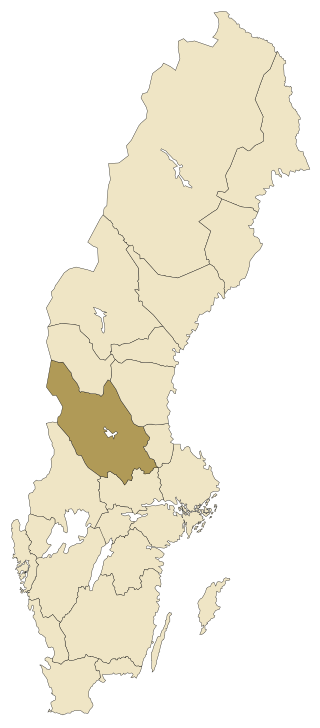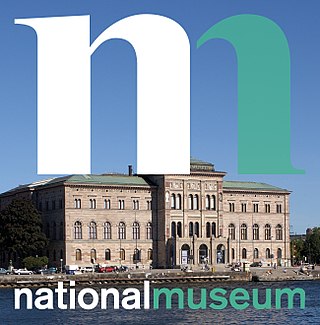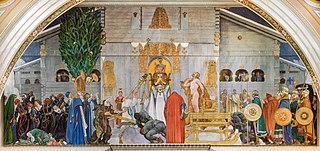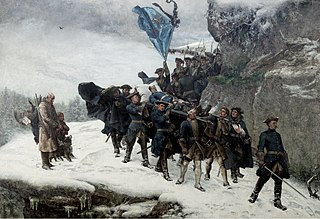
Carl Olof Larsson was a Swedish painter representative of the Arts and Crafts movement. His many paintings include oils, watercolors, and frescoes. He is principally known for his watercolors of idyllic family life. He considered his finest work to be Midvinterblot, a large painting now displayed inside the Swedish National Museum of Fine Arts.

A maypole is a tall wooden pole erected as a part of various European folk festivals, around which a maypole dance often takes place.

Anders Leonard Zorn was a Swedish painter. He attained international success as a painter, sculptor, and etching artist. Among Zorn's portrait subjects include King Oscar II of Sweden and three American Presidents: Grover Cleveland, William H. Taft, and Theodore Roosevelt. At the end of his life, he established the Swedish literary Bellman Prize in 1920.

Dalarna is a landskap in central Sweden. English exonyms for it are Dalecarlia and the Dales.

Midsummer is a celebration of the season of summer usually held at a date around the summer solstice. A variety of traditions have developed, linked to regions as well as religious practice.

The Zorn Collections, or Zornsamlingarna, is a Swedish state museum, located in Mora, dedicated to preserving the works by painter Anders Zorn.

Rose-painting, rosemaling, rosemåling or rosmålning is a Scandinavian decorative folk painting that flourished from the 1700s to the mid-1800s, particularly in Norway. In Sweden, rose-painting began to be called dalmålning, c. 1901, for the region where it had been most popular and kurbitsmålning (kurbits), in the 1920s, for a characteristic trait, but in Norway the old name still predominates beside terms for local variants. Rose-painting was used to decorate church walls and ceilings. It then spread to wooden items commonly used in daily life, such as ale bowls, stools, chairs, cupboards, boxes, and trunks. Using stylized ornamentation made up of fantasy flowers, scrollwork, fine line work, flowing patterns and sometimes geometric elements give rose-painting its unique feel. Some paintings may include landscapes and architectural elements. Rose-painting also utilizes other decorative painting techniques such as glazing, spattering, marbleizing, manipulating the paint with the fingers or other objects. Regional styles of rose-painting developed, and some varied only slightly from others, while others may be noticeably distinct.

Mora is a locality and the seat of Mora Municipality in Dalarna County, Sweden, with 10,896 inhabitants in 2010.

Nationalmuseum is the national gallery of Sweden, located on the peninsula Blasieholmen, in central Stockholm.

Swedish art refers to the visual arts produced in Sweden or by Swedish artists. Sweden has existed as a country for over 1,000 years, and for times before this, as well as many subsequent periods, Swedish art is usually considered as part of the wider Nordic art of Scandinavia. It has, especially since about 1100, been strongly influenced by wider trends in European art. After World War II, the influence of the United States strengthened substantially. Due to generous art subsidies, contemporary Swedish art has a big production per capita.
Sweden Day is a Midsummer celebration honoring Swedish American heritage and history, held annually in New York City since 1941.

Midvinterblot is a painting by the Swedish painter Carl Larsson, created in 1915 for the hall of the central staircase in Nationalmuseum in Stockholm. It has been called Sweden's most controversial painting.

Hanna Hirsch, later Hanna Pauli, was a Swedish painter; primarily of genre scenes and portraits.

Robert Thegerström was a Swedish painter and graphic artist.

Kilian Christoffer Zoll was a Swedish painter, graphic artist and illustrator in the style of the Düsseldorf School. He created genre scenes, landscapes, altarpieces and portraits.

Johan Krouthén was a Swedish artist. He broke away from the traditions of the Swedish Academy, turning to Realism and Idealism. Immediately after his studies, he spent a few months in Paris and in Denmark where he associated with the Skagen Painters. Back in Sweden he painted pictures of gardens and portraits of local people.

Pehr Hörberg was a Swedish artist, painter and musician. In 1769 he married the maid Maria Eriksdotter and they had three sons.

En premiär is an artwork by Swedish artist Anders Zorn, with several versions created from 1888 to 1895. The work was one of several works in which Zorn depicted woman bathing outdoors, a genre he described as "naked studies in the open". In this composition, a nude woman holding a small child at the edge of the water beside a beach. Different versions are held by the Nationalmuseum in Stockholm, the Ateneum in Helsinki, and the Museum of Fine Arts in Ghent.

Omnibus is an oil-on-canvas painting created during 1891–92 by the Swedish artist Anders Zorn. There are two versions of the painting – the first one is exhibited at Nationalmuseum in Stockholm and the second in Isabella Stewart Gardner Museum in Boston.

Bringing Home the Body of King Charles XII is a painting by Swedish artist Gustaf Cederström, painted in Paris in 1878, displayed at Gothenburg Museum of Art. The author painted a second version in 1884, which is now on display in the National Museum in Stockholm. The scene depicts the repatriation of the body of Charles XII of Sweden, who was killed in Norway during the Siege of Fredriksten.




















